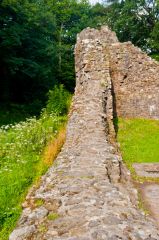Ewloe Castle
History, tourist information, and nearby accommodation
HERITAGE RATING: 

The origins of Ewloe Castle are somewhat unclear. There may have been a simple earthwork and timber fortification here from the time of Owain Gwynedd, but the earliest record we have of a castle at Ewloe dates from 1257, after Llewelyn Fawr captured this area of Flintshire from the English crown.
The castle stands on a treed promontory facing eastward, above the Wepre valley. It is defended on three sides by steep slopes, so all Llewelyn had to do was dig a deep ditch across the neck of the promontory to create a defensible site for his new fortress. Llewelyn's castle consisted of a D-shaped tower of sandstone, with an oval enclosure.
A later phase of construction added a curtain wall and a west tower. There is no apparent link between the two enclosures, and it is possible that they maintained separate entrances, or were even occupied by two separate families or princely households, operating independent of each other.
Ewloe was taken by Edward I in his first incursion into Wales in 1277, and was never again used for military purposes, gradually decaying into the romantic ruin we see today.
Most photos are available for licensing, please contact Britain Express image library.
About Ewloe Castle
Address: Ewloe,
Hawarden,
Flintshire,
Wales
Attraction Type: Castle
Location: In Wepre Country Park, 2 m NW of Hawarden, on the B5125. Note that the castle lies north of the A494, while the village of Ewloe lies to the south of the road! It is a 15 minute walk from the Wepre visitor centre, or a much shorter walk from a layby on the B5125 between Ewloe and Northop Hall. Free access.
Website: Ewloe Castle
Cadw
Location map
OS: SJ288 675
Photo Credit: David Ross and Britain Express
Opening Details: Open access site, usually accessible at any reasonable time
HERITAGE
 We've 'tagged' this attraction information to help you find related historic attractions and learn more about major time periods mentioned.
We've 'tagged' this attraction information to help you find related historic attractions and learn more about major time periods mentioned.
Find other attractions tagged with:
castle (Architecture) -
Edward I (Person) -
Llewelyn Fawr (Person) -
Owain Gwynedd (Person) -








 We've 'tagged' this attraction information to help you find related historic attractions and learn more about major time periods mentioned.
We've 'tagged' this attraction information to help you find related historic attractions and learn more about major time periods mentioned.




